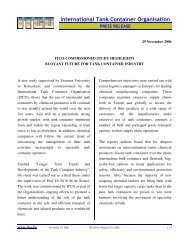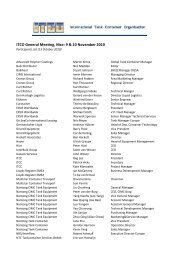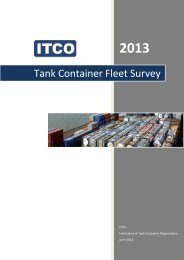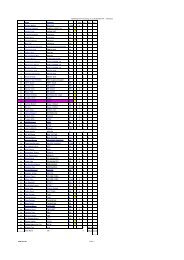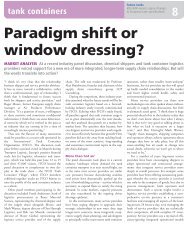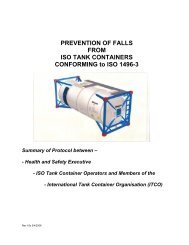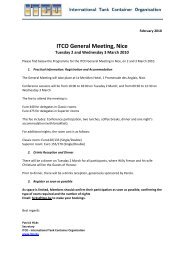Create successful ePaper yourself
Turn your PDF publications into a flip-book with our unique Google optimized e-Paper software.
ICHCA International <strong>Safe</strong>ty Panel Briefing Pamphlet No 30<br />
within Europe to describe road and rail transport modes and is used in place<br />
<strong>of</strong> Intermodal transport within the IMDG Code.<br />
Portable <strong>Tank</strong> means a multimodal tank used for the transport <strong>of</strong> substances<br />
<strong>of</strong> class 1 to 9. The portable tank includes a shell fitted with service<br />
equipment and structural equipment necessary for the transport <strong>of</strong><br />
dangerous substances. The portable tank shall be capable <strong>of</strong> being filled<br />
and discharged without removal <strong>of</strong> its structural equipment. It shall possess<br />
stabilising members external to the shell, and shall be capable <strong>of</strong> being lifted<br />
when full. It shall be designed primarily to be loaded onto a transport vehicle<br />
or ship and shall be equipped with skids, mountings or accessories to<br />
facilitate mechanical handling. A portable tank for the transport <strong>of</strong> nonrefrigerated<br />
liquefied gases <strong>of</strong> class 2 shall have a capacity <strong>of</strong> more than<br />
450 litres.<br />
Service Equipment as used in the IMDG Code means measuring instrument<br />
and filling, discharge, venting, safety, heating, cooling and insulating<br />
equipment.<br />
Shell means the part <strong>of</strong> the portable tank which retains the substance<br />
intended for transport (tank proper), including openings and their closures,<br />
but does not include service equipment or external structural equipment.<br />
Shells may be <strong>of</strong> two basic types, either:<br />
“atmospheric” with little or no capability <strong>of</strong> withstanding an internal<br />
pressure higher than the external pressure; or<br />
“pressure vessel” which have the capability <strong>of</strong> withstanding a higher<br />
internal pressure than the external pressure acting upon the outer<br />
surface.<br />
International regulation governing the transport <strong>of</strong> dangerous goods at sea<br />
prohibits the use <strong>of</strong> “atmospheric” tank shells and in practice there are very<br />
few <strong>of</strong> these types <strong>of</strong> tanks in service.<br />
Structural Equipment means the reinforcing, fastening, protective and<br />
stabilising members external to the shell.<br />
<strong>Tank</strong> Container means a portable tank with fittings, structural capabilities<br />
and dimensionsthat enable it to be handled and secured by the same means<br />
as any ISO or EN configured container.<br />
Tare means the weight <strong>of</strong> the tank container in its unloaded state. It<br />
includes the shell. service and structural equipment.<br />
UIC means Union International des Chemins de Fer and UIC Rules refers to<br />
rules for European rail transport.<br />
Ullage means “the amount by which a container, such as a bottle, cask, or<br />
tank, falls short <strong>of</strong> being full”<br />
Page 46 ©ICHCA International Limited



